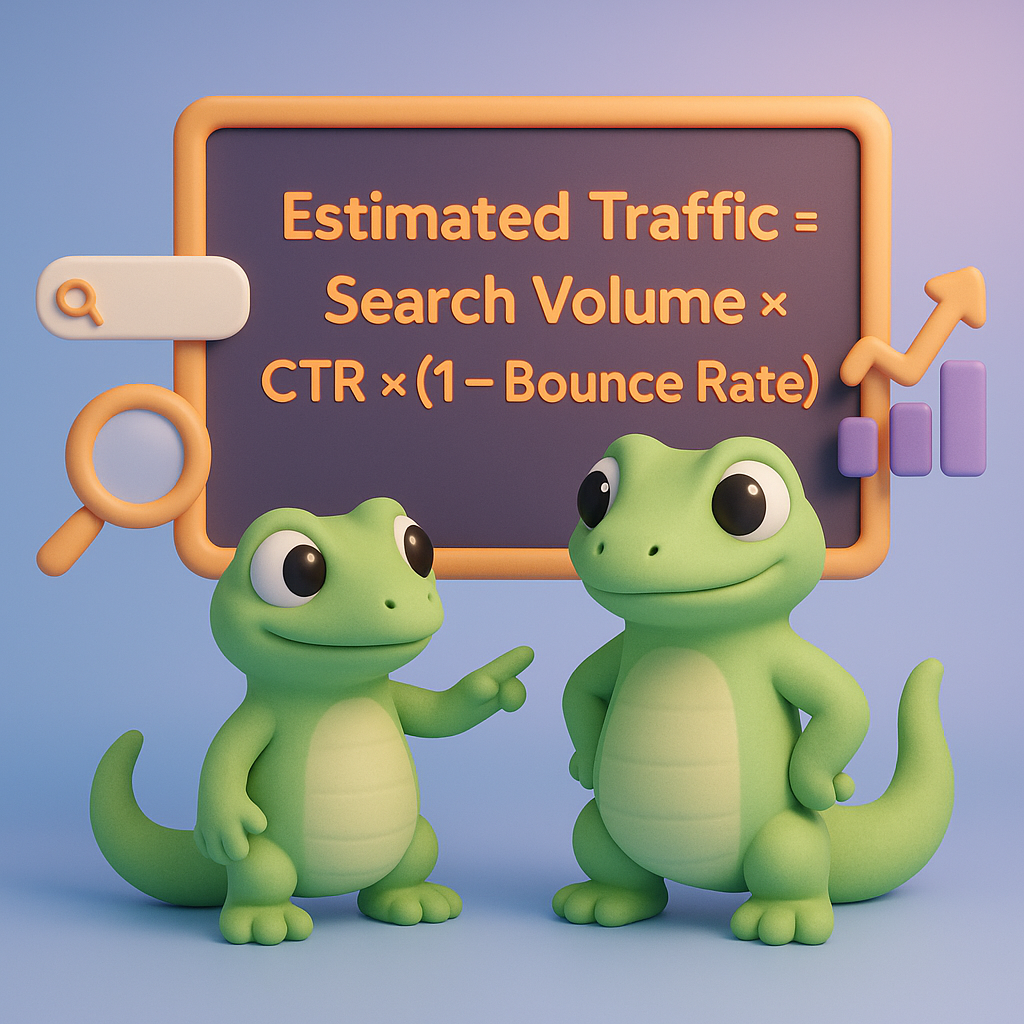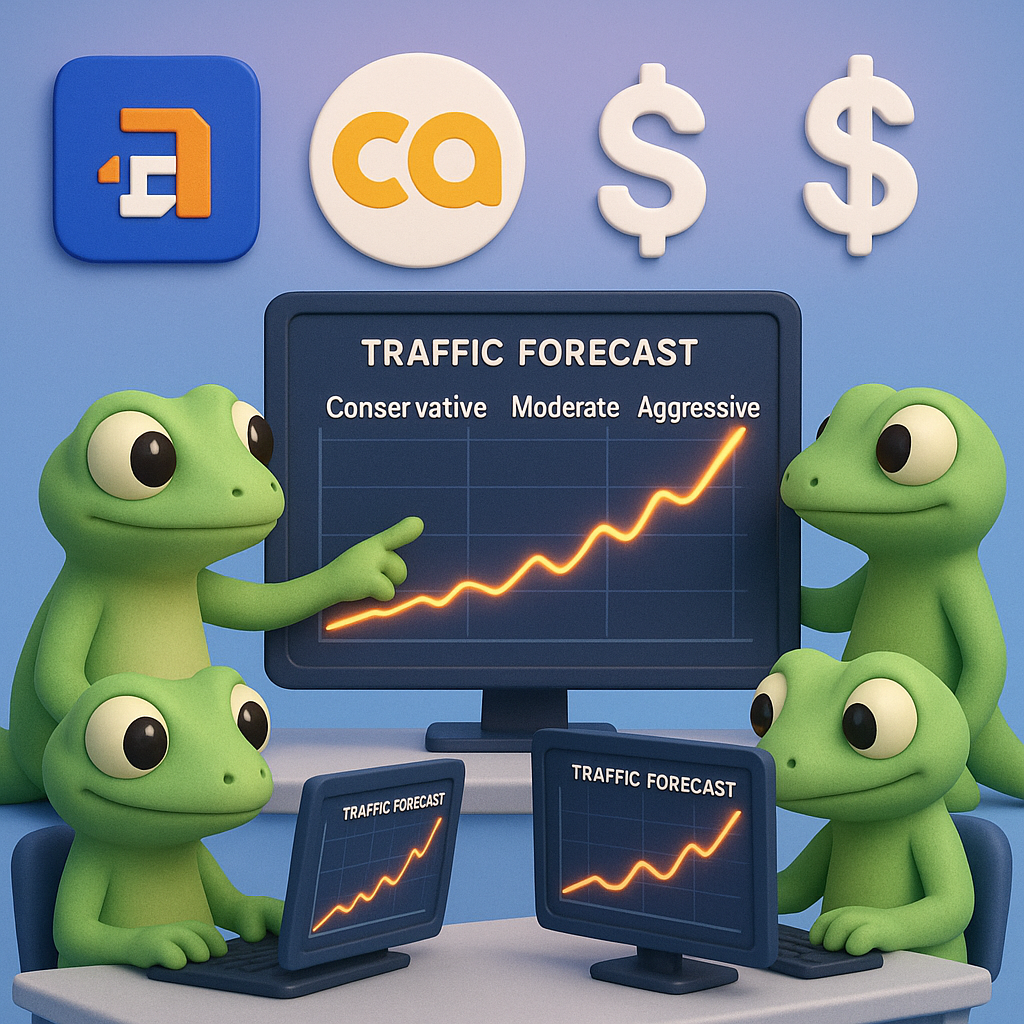How to estimate SEO traffic for organic growth
Forecasting SEO traffic isn’t just a nice-to-have—it’s critical for securing budget, setting realistic expectations, and demonstrating the value of organic search investments. While perfect accuracy is impossible, directionally correct forecasts provide the foundation for data-driven SEO strategy. Think of SEO forecasting as weather prediction: you’ll never be 100% accurate, but you can be accurate enough to know whether to pack an umbrella.
The fundamentals of SEO traffic estimation
Before diving into complex forecasting models, understand these core traffic estimation frameworks:
1. Keyword volume-based estimation
The simplest approach uses this formula:
Estimated Traffic = Search Volume × Expected CTR × (1 - Bounce Rate)For example, if a keyword gets 10,000 monthly searches, ranking in position 3 might yield a 15% CTR, potentially delivering 1,500 monthly visitors.

CTR benchmarks vary significantly by:
- Ranking position
- SERP features (featured snippets, AI overviews)
- Search intent (informational vs. commercial)
- Keyword type (branded vs. non-branded)
Rather than using industry averages, extract actual CTR data from Google Search Console for your SEO reporting. This provides more accurate baseline metrics specific to your site’s performance.
2. Historical extrapolation
For established sites, historical data provides the foundation for forecasting. Look for:
- Year-over-year growth patterns
- Seasonal fluctuations
- Impact of previous SEO initiatives
Linear regression or time-series analysis can help project these patterns forward. For example:
Traffic (Jan 2025) = Traffic (Jan 2024) × (Traffic Growth Rate + Seasonal Coefficient)This approach is particularly effective for websites with at least 12-24 months of historical data, as it captures both annual cycles and long-term trends.
Practical SEO forecasting with Ahrefs
Ahrefs provides powerful data for traffic forecasting when combined with other tools. Here’s a step-by-step approach:
Forecasting keyword ranking potential
-
Export keyword data from Ahrefs:
- Navigate to Keywords Explorer
- Enter target keywords
- Export data including search volume, keyword difficulty, and current rankings
-
Segment keywords by difficulty and intent:
- Group keywords by difficulty (easy, medium, hard)
- Classify by intent (informational, commercial, transactional)
- Tag keywords vulnerable to zero-click searches
-
Apply CTR models based on projected rankings:
- Use position-based CTR estimates (position #1: ~20-30%, position #5: ~5-10%)
- Adjust CTR downward for SERP features like featured snippets or AI overviews
- Calculate potential traffic for each keyword group
-
Create multiple scenarios:
- Conservative (ranking improvements for low-difficulty terms only)
- Moderate (improvements across low and medium difficulty)
- Aggressive (improvements across all difficulty levels)
For example, in a conservative scenario, you might forecast improving from position #8 to position #3 for low-difficulty keywords only, while an aggressive scenario might include jumping to position #1 for medium-difficulty terms and breaking into the top 5 for high-difficulty keywords.

Advanced forecasting with Google Colab + Ahrefs
For more sophisticated projections, use Python notebooks with Ahrefs data:
- Download historical ranking and traffic data from Ahrefs
- Use a pre-built Google Colab notebook (several are available in the SEO community)
- Upload your data and customize parameters:
- Adjust for seasonality
- Set growth rate assumptions
- Factor in algorithm updates
This approach can generate:
- Projected traffic growth curves
- Revenue forecasts (when combined with conversion rates)
- Competitor traffic projections for benchmarking
The power of this method lies in automating complex calculations while allowing customization based on your specific business context and historical performance.
SEO ROI calculation
Traffic forecasts gain significance when tied to business outcomes. Use our free SEO ROI calculator to translate traffic projections into expected returns.
The comprehensive formula for SEO ROI includes:
SEO ROI = ((Additional Traffic × Conversion Rate × Average Order Value) - SEO Investment) ÷ SEO InvestmentRemember to account for:
- Traffic retention after active SEO efforts (the “hang time”)
- Traffic decay rates for unattended content
- Different conversion rates across traffic segments
For example, if your SEO investment is $10,000 and you project gaining 5,000 additional visitors with a 2% conversion rate and $100 average order value, your calculation would be:
ROI = ((5,000 × 0.02 × $100) - $10,000) ÷ $10,000 = $0 ÷ $10,000 = 0%This indicates a break-even point. Any improvement in traffic, conversion rate, or order value would push this into positive ROI territory, showing the return on investment for SEO.
Improving forecast accuracy
1. Account for seasonality
Seasonal factors significantly impact traffic. Apply seasonal coefficients based on historical patterns:
Adjusted Traffic Forecast = Base Forecast × (1 + Seasonal Coefficient)For example, an e-commerce site might apply a +30% coefficient for December and -15% for summer months. This reflects the reality that consumers search differently throughout the year, especially for products with distinct seasonal demand patterns.
2. Segment by content type
Different content types perform differently in search. Create separate forecasts for:
- Product pages
- Informational content
- Category pages
- Brand terms
This enables more precise projections and better resource allocation. For instance, informational content might convert at 1% while product pages convert at 5%, dramatically changing your ROI calculations despite similar traffic levels.
3. Factor in algorithm volatility
Recent Google updates have increased ranking volatility. Mitigate this by:
- Building scenario-based forecasts (best, worst, and expected cases)
- Incorporating buffer periods after known algorithm update windows
- Regularly recalibrating forecasts against actual performance
The introduction of AI Overviews in 2023-2024 has particularly impacted informational queries, making this adjustment more important than ever for accurate forecasting.
4. Use machine learning
For enterprise-scale forecasting, machine learning models can improve accuracy by incorporating:
- Historical ranking data
- Seasonality patterns
- SERP feature prevalence
- Competitive density
Tools like seoClarity offer AI-powered forecasting features, though simpler regression models in Excel can also be effective for smaller sites. The key advantage of machine learning is its ability to identify non-obvious patterns in your historical data that might influence future performance.
Common forecasting pitfalls
Avoid these common errors in SEO traffic estimation:
-
Ignoring traffic quality - Not all traffic has equal value. Use free keyword clustering tools to group keywords by intent and value.
-
Overlooking zero-click searches - With Google’s expanded SERP features and AI overviews, many searches no longer result in clicks. Adjust CTR expectations accordingly, especially for definition-based and simple informational queries.
-
Linear projection bias - SEO growth rarely follows a straight line. Account for diminishing returns as rankings improve. The jump from position #20 to #10 might be easier than moving from #3 to #2.
-
Neglecting competition - Competitive rankings are dynamic. Track competitor movements using keyword tracking tools to refine forecasts.
-
Ignoring technical limitations - Site performance, crawlability issues, or content quality problems can cap traffic growth potential. The most optimistic forecasts won’t materialize if technical fundamentals aren’t addressed.
Advanced SEO forecasting techniques
For sophisticated forecasting needs:
Content gap analysis prediction
- Use Ahrefs Content Gap analysis to identify keywords competitors rank for that you don’t
- Classify gaps by difficulty and search volume
- Apply expected CTR models to project potential traffic from closing these gaps
- Create timelines for capturing this traffic based on content creation capacity
This approach is particularly valuable for identifying “low-hanging fruit” — keywords where competitors rank well but you don’t, despite having relevant content or products. These opportunities often represent the fastest path to traffic growth.
AI-powered predictive analytics
Implement machine learning models that incorporate:
- Historical ranking and traffic data
- Seasonality patterns
- Content publication schedule
- Technical SEO improvements
- Backlink acquisition rate
These models can predict traffic with increasing accuracy as they learn from actual performance data. For example, after analyzing thousands of data points, an AI model might discover that your site typically sees ranking improvements 45 days after content publication, allowing for more precise timing in your forecasts.
Competitive benchmark forecasting
- Identify 3-5 competitors in your niche with similar business models
- Use Ahrefs to extract their historical traffic patterns
- Calculate their growth rates and traffic distributions
- Use these as benchmarks for your own potential growth
This technique is especially useful for new sites without extensive historical data. By studying the growth trajectories of established competitors, you can create more realistic forecasts for your own site’s potential.
TL;DR
Effective SEO traffic forecasting combines search volume data, CTR models, and historical performance patterns. Ahrefs provides valuable data, especially when combined with tools like Google Colab for more sophisticated projections. Segment forecasts by keyword types, account for seasonality and algorithm volatility, and tie projections to business outcomes using an SEO ROI calculator. The most successful forecasts don’t aim for perfect precision but provide directionally accurate guidance for strategic decision-making. Remember that forecasting is both art and science—use data to inform your projections, but apply judgment based on your industry knowledge and specific business context.
